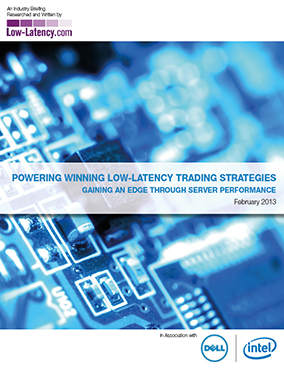TradingTech Insight White Paper
Dell Processor Acceleration Technology Industry Briefing
In the world of the financial markets, securing an edge over the competition can mean life or death for a trading firm. Whether it is acting on news alerts or price movements, determining the best trading opportunity, or delivering an order to the marketplace, microseconds mean the difference between winning or just playing. Reducing those...
Big Data in Trading and Risk Management
This industry briefing – sponsored by SAP – provides insight and analysis on how financial markets firms see Big Data approaches and technologies being leveraged for trading and risk applications. The briefing draws upon research conducted by A-Team Group’s BigDataForFinance.com web community, which included a survey of major financial markets firms based in the U.S. The survey...
Viewpoints on Latency – Thought Leadership at The Cutting Edge of Electronic Trading – November 2012
Viewpoints on Latency is a regular collection of news, thought leadership and opinion from the Low-Latency.com community. In this issue: * Pete Harris of Low-Latency.com provides the low-down on the latest developments at the cutting edge. * Dave Malik of Cisco Systems discusses the performance and analytics of the company’s Nexus 3548 switch. * Donal O’Sullivan of Corvil outlines new...
Lightweight Internet Protocol Stack
Free white paper, authored by GE Intelligent Platforms IP traffic is increasing globally at a breath-taking place. In order to support the demand of high performance IP packet processing particularly for High Frequency Trading applications demanding low latency and higher throughput, users and developers are adopting a novel approach of combining PCI Express packet processing...
Delivering Sub-Microsecond Accurate Time to Linux Applications Around the World
Free white paper, authored by Symmetricom Trading applications at market participants require access to precise timing information – the same precise timing information – in order to transact business profitably, without risk and within regulatory edicts. The key word is precise. Accuracy is vital, and the more accurate the timestamp, the harder it is to...
Mission Possible: Turning Data Deluge into Opportunities for Financial Trading
In the financial trading markets, the race to zero is on, with participants including competing marketplaces, algorithmic trading operations, high frequency trading firms, market data aggregators and execution network providers all playing their role in pushing down transaction times from hundreds of milliseconds to tens of microseconds. Linking all of these players together is data...
High-Performance Trading Infrastructure on Demand
Financial markets firms can no longer spend what it takes to compete in the “low latency arms race.” The new reality demands high performance to be competitive with peers, but with an emphasis on upfront deployment and ongoing operational costs. High performance is measured not simply in trading execution speed and round-trip latency figures. Those...
Measuring Latency in Equity Transactions
This white paper was written by Ixia. Ixia is the Leader in Converged IP Testing and offers solutions for higher speed gigabit Ethernet as well as testing network performance The importance of minimizing latency in data center networks has been discussed intensely in the last year, mostly with respect to trading in financial markets – where...
Viewpoints on Latency – Thought Leadership at The Cutting Edge of Electronic Trading – June 2012
Viewpoints on Latency is a regular collection of news, thought leadership and opinion from the Low-Latency.com community. Low latency is not an island. Other technologies and approaches, such as cloud and big data, all have connections into the latency world, and all will play a part in making tomorrow’s electronic trading markets profitable for players of all types....
A Flexible Approach to Market Infrastructure
The growing speed and complexity of today’s financial markets are placing all but the most technologically well-resourced participants at a strategic disadvantage. Buy- and sell-side firms, the execution venues they use, and the wide range of post-trade, market data and other service providers whose offerings they consume, are all struggling to keep up with the...











